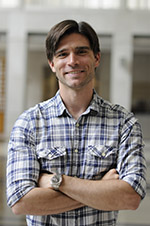
Certain viruses such as measles and mumps employ a membrane envelope to infect host cells and deliver key viral proteins. These enveloped viruses need fusion proteins – small molecular machines on the virus surface – to undergo a refolding process that allows the virus to enter the cell.
Scientists at Northwestern University Feinberg School of Medicine collaborated with Washington University, St. Louis, to use a novel technique that allowed them to analyze the folding process called fast photochemical oxidation of proteins (FPOP).
Using FPOP, Taylor Poor, ’14 PhD, a third-year medical student, investigated this refolding process to better understand infectivity of envelope viruses in the lab of Robert Lamb, PhD, professor in Microbiology-Immunology. While previous studies have determined the starting and ending states of the refolding event, little is known about how fusion proteins transform from one state to another.
“We were trying to determine how the protein got from point A to point B,” said Poor. “If you think about that as a pathway, and a series of folding events, suddenly you see more opportunities to disrupt the function of the protein.”
Facing this challenge, Poor triggered viral fusion proteins to start the refolding process and then used FPOP to label them at different points along the refolding pathway. Poor then observed where the labels were incorporated on the surface of the protein using mass spectrometry. He took this information and mapped it back on to available crystal structures of the protein.
Poor’s work was in the Proceedings of the National Academy of Sciences.
“We think this technique provides a new way of studying difficult-to-address problems in structural biology,” said Poor. “It could be used for studying any protein that has traditionally been difficult to analyze. So the project has been interesting, not just in the context of this particular protein and these particular viruses, but also from the perspective of how it could be applied to other fields.”
The technique allowed Poor to reveal new details of refolding events. By identifying which surfaces were exposed during different stages of the refolding event, scientists could use this information to find potential areas on the protein that could be used for targeted therapeutics.
“Some of the surfaces exposed in this refolding event are critical for viral infection,” he said. “If you interrupt the refolding event and block the function of the fusion protein you block the infectivity of the virus.”
Poor found other structural properties of the fusion protein as it undergoes refolding such as changes in flexibility, energy states and mechanisms that hadn’t been seen before.
Additionally, Poor studied and mapped where neutralizing antibodies bind to these fusion proteins.
“The ideal goal is to find therapies from which the pathogens can’t escape,” said Poor. “One way you can do that is if you can successfully identify pieces of the protein that are absolutely critical for function. If you can do that successfully, you can design a therapeutic to target those regions and create a mutation resistant therapy.”
This research was supported by National Institutes of Health grants R01-Al-23173, r01-GM-61050, R01-GM-094919, P41-GM-103390, and 8 P1 GM103422 and by Science of Ireland Grant 08/IN.1/B2070. The study was also funded by National Institutes Health Training Programs in Cell and Molecular Basis of Disease Grant T32-GM008061 and Viral Replication Grant T32-AI-060523.






